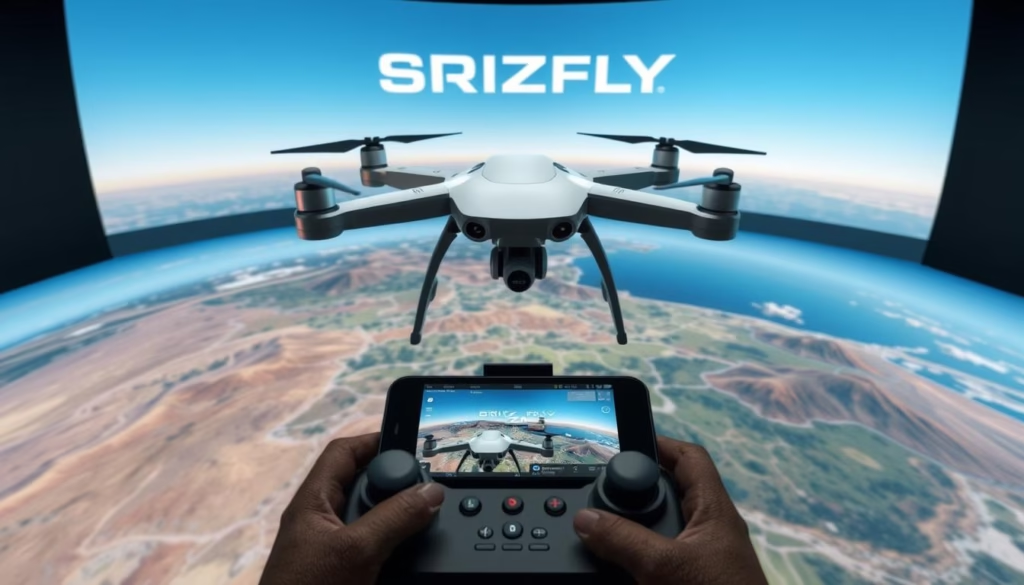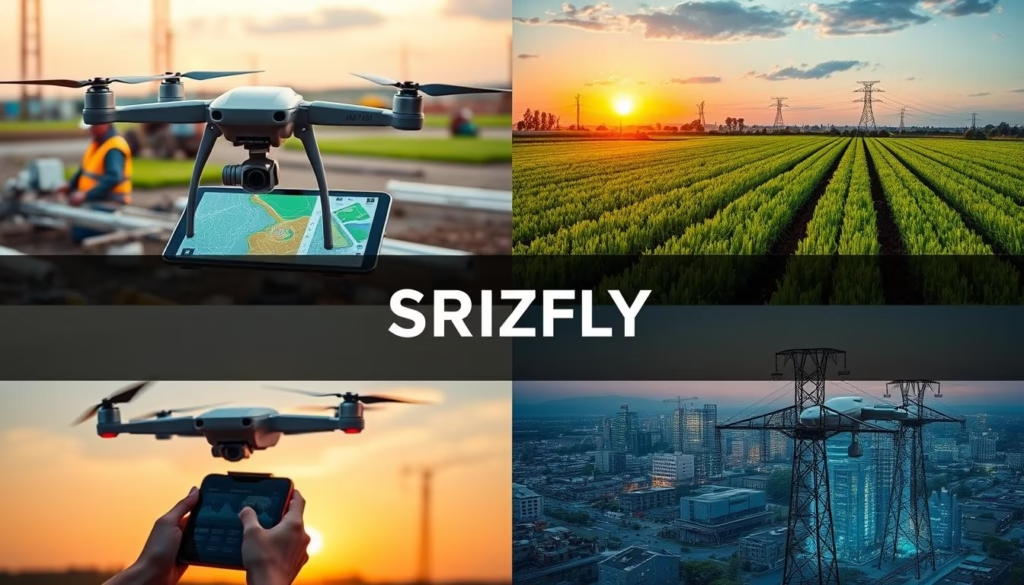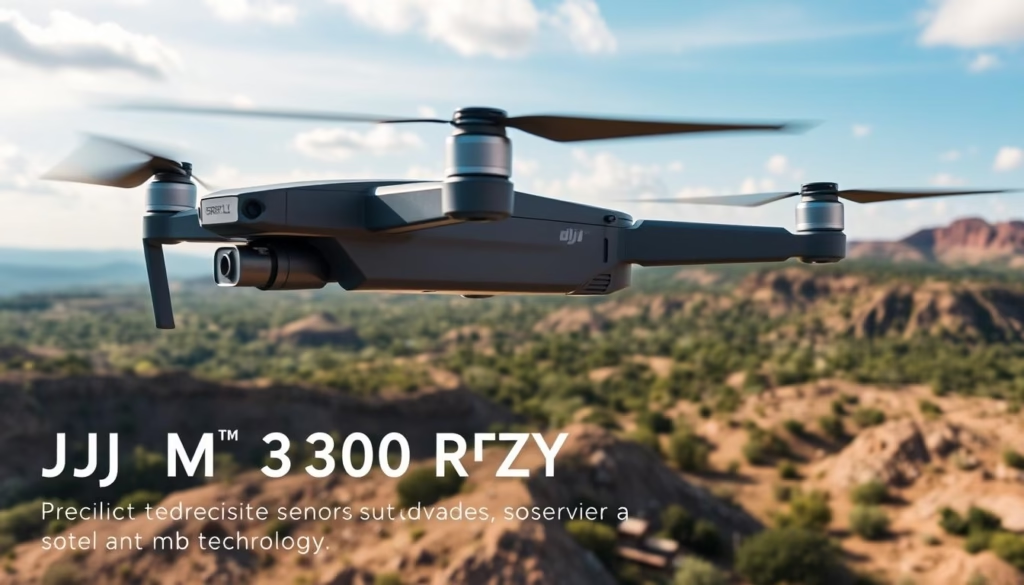The DJI M300 RTK represents a significant enhancement in drone technology, crafted for precision-driven tasks across diverse industries. This advanced DJI drone offers extensive functionalities geared towards surveillance, mapping, and inspection applications. With a maximum payload capacity of 2.7 kg and a flight time reaching up to 55 minutes, the DJI M300 maintains operational flexibility and robustness under varying environmental conditions. Designed with advanced safety features, such as a six-directional vision and infrared sensing system, it ensures comprehensive obstacle detection capabilities. The DJI enterprise drone stands out with its reliability, making it the preferred choice for professional drone operators in search of efficient aerial solutions.
Key Takeaways
- Maximum payload capacity of 2.7 kg, enhancing its versatility in application.
- Remarkable flight time of up to 55 minutes, optimizing operational efficiency.
- Six-directional vision system allows for 360° obstacle avoidance.
- Ready for use in demanding conditions with an IP54 rating for dustproof and waterproof capabilities.
- Incorporates hot-swappable battery technology, enabling quick transitions in the field.
Overview of the DJI M300 RTK Drone
The DJI Matrice 300 RTK stands at the forefront of drone technology, serving as an industrial-grade drone designed to tackle complex tasks across various sectors. With its robust features and advanced capabilities, this dji enterprise drone is tailored for professional use, ensuring maximum reliability and efficiency in demanding environments.
Key Features and Specifications
The M300 RTK showcases remarkable specifications that underscore its utility in critical applications. Below are its standout features:
| Specification | Details |
|---|---|
| Maximum Takeoff Weight | 9 kg |
| Payload Capacity | 2.7 kg |
| Dimensions (Unfolded) | 810 × 670 × 430 mm |
| Dimensions (Folded) | 430 × 420 × 430 mm |
| Maximum Flight Time | 55 minutes |
| Maximum Speed | 82.8 km/h (23 m/s) |
| Wind Resistance | 54 km/h |
| Obstacle Avoidance System | Omnidirectional |
| RTK Positioning | Yes |
Applications in Various Industries
The industrial-grade drone is applicable across a myriad of sectors, including but not limited to:
- Agriculture: Crop monitoring and precision farming
- Construction: Site surveying and 3D mapping
- Public Safety: Search and rescue missions
- Infrastructure: Inspections of bridges, power lines, and railways
With its adept functionality and reliability, the DJI Matrice 300 RTK remains a preferred choice among professionals utilizing dji enterprise drone technology for critical tasks.
Benefits of Using the DJI M300 RTK
The DJI M300 RTK stands out for its exceptional benefits that enhance operational capabilities for drone pilots. With advanced flight technology integrated, this drone offers remarkable features tailored to meet specific mission requirements, ensuring efficiency across various sectors.
Enhanced Flight Performance
The performance metrics of the dji m300 demonstrate its superior capability. With a maximum flight time of 55 minutes when flying without a payload, the M300 RTK consistently outperforms many other models in the market. It can carry a payload of up to 2.7 kg, allowing operators to utilize multiple sensors simultaneously, such as the H20T camera. The M300 RTK can achieve flight times of 43 minutes with this sensor in operation and 31 minutes at its maximum payload capacity of 9 kg.
Additional specifications include:
- Maximum horizontal speed of 23 m/s (approx. 51 mph)
- Maximum ascent and descent rates of 6 m/s and 7 m/s
- Service ceiling of 7,000 meters
- Wind resistance rated at 15 m/s
This advanced flight technology ensures that the dji drone remains reliable under varying conditions, further enhancing its appeal for professional use.
Improved Safety Features
Safety during operations is paramount, and the M300 RTK incorporates several features that enhance pilot confidence. The drone is equipped with six directional sensors and advanced AI operations, which facilitate features like Live Mission Recording and AI Spot-Check. Collision avoidance sensors operate within an adjustable range of 1 to 40 meters, providing operators with an additional layer of safety.
The drone’s dual-battery design allows it to remain operational even if one battery fails, contributing to its reliability. Its emergency landing capabilities enable it to safely descend with just three functional motors in case of a malfunction, making it a foolproof choice for critical missions.
Overall, the combination of enhanced flight performance and improved safety features positions the dji m300 as an indispensable tool for professionals who demand precision and reliability in their aerial operations.
| Feature | Specification |
|---|---|
| Maximum Flight Time (No Payload) | 55 minutes |
| Maximum Flight Time (9 kg Payload) | 31 minutes |
| Maximum Speed | 23 m/s (51 mph) |
| Service Ceiling | 7,000 meters |
| Wind Resistance | 15 m/s |
| Payload Capacity | 2.7 kg |
| Collision Avoidance Range | 1 to 40 meters |
The Role of Drone Simulators
Drone simulation technology plays a vital role in equipping pilots with the necessary skills to operate advanced drones like the DJI M300 RTK. Among the leading tools available, the SRIZFLY drone simulator stands out for its ability to replicate the complex flight dynamics of the M300 RTK, offering an immersive environment for flight training.
Introduction to SRIZFLY Drone Simulator
The SRIZFLY drone simulator is specifically developed to enhance piloting skills for the DJI M300 RTK. This advanced platform accurately mimics flight characteristics and controls, ensuring that both novice and experienced pilots can familiarize themselves with operations and emergency procedures without the need for physical equipment. The simulator supports various training scenarios, reflecting real-world challenges that pilots may encounter.
Benefits of Training with a Simulator
Training with the SRIZFLY simulator provides several advantages, including:
- Cost Efficiency: Reduces training costs associated with equipment wear and tear.
- Safety: Allows for practice in a risk-free environment, minimizing potential accidents.
- Flexibility: Offers various training modules that can be tailored to individual pilot needs.
- Enhanced Skill Acquisition: Facilitates mastery of complex maneuvers and emergency management techniques.
Ultimately, the integration of the SRIZFLY drone simulator into flight training programs empowers pilots with the skills required for effective operation of the DJI M300 RTK, advancing their proficiency and confidence.

How SRIZFLY Supports DJI M300 RTK Pilots
The SRIZFLY SESP-U1 Drone Simulator offers a comprehensive environment for pilots training with the DJI M300 RTK. By incorporating advanced simulation software, SRIZFLY enhances the skill development process tailored specifically for drone operator training.
User-Friendly Interface
The simulator features an intuitive interface that simplifies navigation and operation. This accessibility ensures that drone operators of all proficiency levels can quickly familiarize themselves with the software. Key functionalities are designed to be easily navigable, allowing pilots to concentrate on enhancing their skills without being distracted by complicated operating procedures.
Realistic Flight Scenarios
SRIZFLY empowers pilots through realistic flight scenarios. The simulator accurately portrays varying weather conditions, daytime settings, and night flight options. This high level of realism provides invaluable practice for professional UAV operators preparing to use the DJI M300 RTK in real-world situations. Pilots can gain experience in advanced maneuvers while tracking flight performance with metrics such as flight duration and distance traveled.
Advantages of Mastering Drone Operation
Achieving proficiency in drone operation provides substantial benefits for pilots, particularly in the context of the dji matrice 300 rtk. Mastery improves confidence levels in executing complex tasks, which can significantly affect operational success. Understanding the technical capabilities and safety measures associated with this advanced drone enhances overall drone safety.
Increased Pilot Confidence
With extensive training, drone operation skills are honed, leading to greater pilot confidence. Operators familiar with the features of the dji matrice 300 rtk, such as its maximum takeoff weight of 9 kg and maximum flight time of 55 minutes, can make quicker and more informed decisions during flights. This confidence allows pilots to tackle challenging environments and intricate maneuvers effectively.
Reduction in Equipment Damage
Proficient operators minimize the risk of damaging their equipment by employing best practices learned through training. Familiarity with the drone’s specifications, including wind resistance of 15 m/s and effective payload capacity of 2.7 kg, contributes to better management of flight conditions. The decrease in mishaps ultimately prolongs the lifespan of the dji matrice 300 rtk and its accessories.
Industry Use Cases for DJI M300 RTK
The DJI M300 RTK excels in a variety of applications, demonstrating its versatility and reliability in demanding environments. With advanced features suited for different operational needs, this dji enterprise drone plays a pivotal role in enhancing efficiency across various sectors.
Search and Rescue Operations
In critical situations, the DJI M300 RTK proves essential for search and rescue missions. Equipped with specialized payloads, including the thermal camera from the Zenmuse H20T, the drone can cover vast areas with ease. This capability allows operators to locate missing persons in challenging terrains. The drone’s long flight time of up to 55 minutes when utilizing two TB60 batteries ensures extended operational windows, maximizing the efficiency of rescue teams.
Infrastructure Inspections
Infrastructure inspections benefit greatly from the precision and advanced imaging capabilities offered by the DJI M300 RTK. This commercial drone supports multiple payload configurations, allowing the integration of high-resolution cameras and LiDAR systems. The maximum flight speed of 23 m/s enables rapid data acquisition, essential for assessing the condition of critical infrastructure such as bridges, power lines, and pipelines. The drone’s ability to operate in real-time, combined with its reliable transmission range of up to 15 km through OcuSync Enterprise, enhances inspection capabilities, ensuring that data is collected and analyzed promptly.

Best Practices for Operating a DJI M300 RTK
To ensure optimal performance and safety when operating the DJI M300 RTK, adherence to drone operational best practices is essential. By focusing on thorough pre-flight checks and precise in-flight maneuvers, operators can enhance flight safety and maximize the drone’s capabilities.
Pre-Flight Checks
Before launching the DJI M300 RTK, operators should conduct extensive pre-flight inspections. This process includes the following crucial points:
- Check battery levels, ensuring all Intelligent Flight Batteries are fully charged.
- Examine the gimbal movement and payload attachment for security.
- Verify that at least 7 satellites are connected for reliable GNSS positioning.
- Inspect propellers for any visible deformations or damage, replacing them if necessary.
- Confirm the calibration of control sticks on the remote controller.
- Ensure that failsafe settings are configured correctly to minimize risks during operation.
- Review firmware and software updates to guarantee optimal performance.
In-Flight Maneuvers
Maintaining precision and control while flying the DJI M300 RTK is paramount for flight safety. Key considerations for in-flight maneuvers include:
- Maneuvering the aircraft must be executed with careful attention to drift limits; horizontal drift should remain within 1 meter, while height drift should not exceed 0.5 meters.
- During P-mode operations, the aircraft should hover at a height of 5 meters for at least one minute to verify stability.
- Prior to any mission uploads, ensure that the aircraft is on the ground and rotors are stopped.
- A thorough understanding of the Remote Controller’s features will aid in effective management during tasks.
- Post-flight checks should include confirming the integrity of all components and ensuring that the aircraft is clean and ready for future use.
Maintenance Tips for Longevity
To ensure optimal performance and durability of the DJI M300 RTK, proper drone maintenance practices are essential. Consistent attention to software updates and physical upkeep not only enhances the drone’s efficiency but significantly contributes to dji drone longevity.
Regular Software Updates
Frequent software updates play a critical role in maintaining the functionality of the DJI M300 RTK. These updates allow the drone to adapt to evolving operational requirements and improve overall security. Users should take advantage of the Pilot App, which facilitates simultaneous updates for up to eight batteries, ensuring all components perform cohesively. Delaying updates may lead to vulnerabilities and hinder performance enhancements, impacting overall drone maintenance.
Cleaning and Care
Routine cleaning is a vital aspect of hardware upkeep for the DJI M300 RTK. Regular inspections should include:
- Monitoring battery condition and voltage levels
- Cleaning camera and sensors to ensure image integrity
- Checking the integrity of propellers and replacing them when necessary to avoid increased motor stress
- Inspecting motors and connections to prevent overheating risks
- Storing the drone in a clean, dry environment to minimize moisture damage
By implementing these maintenance tips, operators can significantly enhance the longevity of their drones while reducing the likelihood of costly repairs and operational downtime.
| Maintenance Activity | Frequency | Benefits |
|---|---|---|
| Software Updates | Regularly (as available) | Enhances performance and security |
| Battery Checks | Before each flight | Ensures optimal operation and prevents failures |
| Physical Inspections | Every flight | Identifies issues before they escalate |
| Cleaning | After each use | Maintains sensor integrity and prevents wear |
| Propeller Replacement | As needed | Reduces stress on motors and enhances flight stability |
Future Trends in Drone Technology
The future of drone technology is poised for significant advancement, particularly in the area of autonomous flight. As the global earth observation drone market expands, with projections indicating a jump from USD 9,620 million in 2022 to USD 17,244 million by 2031, key future drone trends manifest in heightened efficiency and reduced pilot workload. Improved artificial intelligence systems will enable drones, such as the DJI M300 RTK, to execute complex missions autonomously, thereby redefining operational capabilities across various sectors.
Advancements in Autonomous Flight
Recent developments demonstrate a clear trajectory towards sophisticated autonomous drones. The enhanced IP55 rating of the M350 RTK compared to the M300 RTK’s IP45 showcases durability improvements necessary for diverse operational environments. Additionally, longer transmission distances and extended battery life exemplify the increasing integration of AI in aviation, facilitating real-time decision-making and increased autonomy in mission-critical operations.
The Emerging Role of AI in Drones
As ingrained AI capabilities become standard in contemporary drone models, efficiency, data processing, and operational safety are expected to improve dramatically. The industry will likely witness innovative applications in transportation, surveillance, and environmental monitoring driven by AI technologies, further bolstering the already considerable interest in commercial and industrial drone applications. These trends underline the essential role of AI in shaping the future landscape of drone technology.
FAQ
What is the maximum payload capacity of the DJI M300 RTK?
The DJI M300 RTK can carry payloads of up to 2.7 kg, allowing for the simultaneous use of various sensors and equipment for diverse applications.
How long can the DJI M300 RTK fly on a single charge?
The DJI M300 RTK boasts a maximum flight time of up to 55 minutes, providing extended operational capabilities for various missions.
What safety features are integrated into the DJI M300 RTK?
The DJI M300 RTK is equipped with an omnidirectional obstacle avoidance system, enhancing safety during operations. This system works in conjunction with advanced AI features for mission efficiency.
How does the SRIZFLY drone simulator aid in piloting the M300 RTK?
The SRIZFLY drone simulator accurately replicates the flight characteristics of the DJI M300 RTK, providing a comprehensive learning environment for both novice and experienced pilots to develop their skills safely.
What is the significance of RTK positioning in the DJI M300 RTK?
RTK positioning enhances the drone’s navigation accuracy, which is crucial for applications requiring high precision, such as surveying and mapping.
Can the DJI M300 RTK be used for search and rescue operations?
Yes, the DJI M300 RTK is highly suitable for search and rescue operations due to its long flight time, advanced camera systems, and obstacle avoidance capabilities that allow it to operate effectively in challenging terrains.
What are the best practices for pre-flight checks of the DJI M300 RTK?
Operators should inspect battery levels, gimbal movements, payload attachment security, and ensure all software updates are completed prior to flight to guarantee safe operation.
Why are regular software updates important for the DJI M300 RTK?
Regular software updates are crucial as they enhance functionality, improve security, and introduce new features tailored to evolving operational requirements.
What advancements are expected in drone technology regarding the DJI M300 RTK?
Future trends may include enhanced levels of autonomy and improved artificial intelligence systems, allowing the DJI M300 RTK to conduct complex missions with reduced pilot workload.



